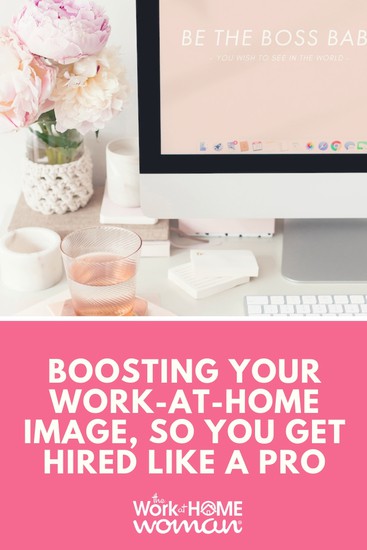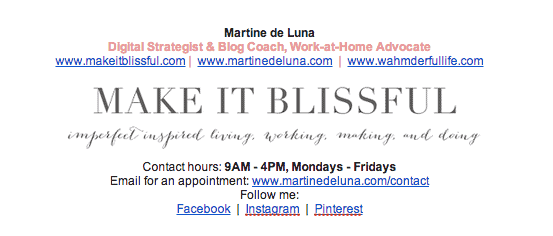I’ve been working at home for years now. In the beginning, I had no clue about what I was doing. I remember the first time a potential client asked me to “sell” him something over the phone so he could “test” my skills as a copywriter.
 I, having no professional copywriting experience whatsoever (I am a former preschool tutor and an urban-based missionary!), took on the challenge. I thought: How would I respond to an ad or a website trying to sell me lipstick as my client asked? I’d never written ad copy before, and I had certainly never worked with anything more than construction paper and worksheets.
I, having no professional copywriting experience whatsoever (I am a former preschool tutor and an urban-based missionary!), took on the challenge. I thought: How would I respond to an ad or a website trying to sell me lipstick as my client asked? I’d never written ad copy before, and I had certainly never worked with anything more than construction paper and worksheets.
What did I do?
Well, I plucked up my courage, used my writing experience in creative writing and in ten minutes, wrote an elevator pitch for lipstick — my first attempt to ever do anything unrelated to ministry work, education, and teaching. To cut the story short, I sealed that client. I was placed immediately as the creative copy and editorial director of the company (a cloud-based one), from all the way here in the Philippines. I worked with them for three years, creating campaigns for social media, copy for their brands — with nothing more than a preschool tutor’s experience under my belt.
That was when I realized I could hustle anything, even my abilities as a work-from-home professional. I could set myself up to do any task that a potential client would ask me to (as long as it in my skill set), or learn anything that was asked of me.
It all started with presenting myself professionally to my clients, even if I was not totally experienced or “expert” at what I was going to do.
Here are five fool-proof tips that I can offer you, ladies when it comes to boosting your work-at-home image. I can say these have all paid off for me!
1. Branding
I’m talking about putting a “face”, an “identity” on your brand. You don’t even have to work with a graphic designer yet on your business branding. Just be consistent with the basic elements such as typography (fonts) and color palette.
Go to Google.com/fonts and see what fonts can help “brand” your correspondence and image. Use this font for the headers in your email signatures, newsletters, your blog or website, social media accounts, collaterals, and business cards. I recommend choosing a combination of a serif font (like Garamond), and a creative font (calligraphic, handwritten), if you are in the creative business.
Avoid overused fonts, like Comic Sans, Times New Roman, and the like. Keep things simple and clean. Remember: Less is more when it comes to professional-looking branding.
2. Email Signature
Label all of your emails with a memorable signature that uses your branding (typography and color palette). My email signature includes the essential elements of my brand: My name, my brand logo, job description, my websites, and social media links. You can include phone numbers, office hours, and other details. I use Gmail to create my signature since I link all my custom emails to Gmail.
Here is my current signature, for reference. (Images are linked from my blog site, where they are hosted).

3. Blog or Website
This is one of the best branding investments you can make for your freelance venture or online business. It takes a bit of your budget to invest in a blog or website, but it is a worth-it investment in the long run.
With me, it began with saving a little of my profits each month and using those towards a “branding fund” for my business. You can DIY your design as much as you want; you don’t necessarily have to hire someone to design a blog or website for you. I DIY’d my blog design in the beginning, starting with a custom domain from Blogger.com and BTemplates before making the leap to a self-hosted WordPress.org website.
I used free templates on WordPress before hiring a designer to do a real professional brand kit for me. The key is to begin branding at some point so that you can build up to your design investment when the time comes. (The same applies for your social media account profile photo and backgrounds.)
Related Content: How to Start a Blog and Make Money From It

4. Stationery
I only got to making business cards when I stopped doing employed online work and started to run a small business of my own. Business cards didn’t take much of an investment after I had my brand logo. I simply took the brand logo, did a bit of template work using Microsoft Office, and printed my own business cards. This made it easier for me to spread my brand for my locally-accessible clients. Eventually, I was able to get the cards digitally printed in big quantities.
Related Content: 6 Elements That Can Set Your Online Profile Apart From the Competition
5. Professional Work Hours
Being a work-at-home woman can often mean getting addicted to working. I used to have a HUGE problem with this. Good thing, the time management resources here at TWAHW helped me with time and productivity.
I don’t always get work hours right (I still fail hugely at times), but at least I know now that I can delegate duties, manage email a bit more effectively, and say “no” to projects and clients when I know I can’t take the load.
I’ve also learned to establish work hours and STICK to them. I used to fear that if I didn’t answer every email or entertain every inquiry that I would lose business. However, I discovered that when I “trained” my clients and customers to respect my business hours, they worked with me more effectively. They knew I would only answer emails and calls at my most effective time when I was not doing anything creative or doing strategy work (my core strengths). I also stopped reading emails during weekends, so that people knew I could only be reached during work hours.
Conclusion.
Little adjustments like these — branding, online presence, and work hours — can all help us boost our professional identity as work-at-home women. These mini-transformations to our online identities can help us get better clients, even better work hours and pay. In the end, it rings true that we get the return of our investment, and that includes investing in ourselves and our professional identity.
Have you tried any of them? What has been working so far for you? And, if you’ve not tried them, what could you do to “up” your game as an online professional?








Leave a Comment